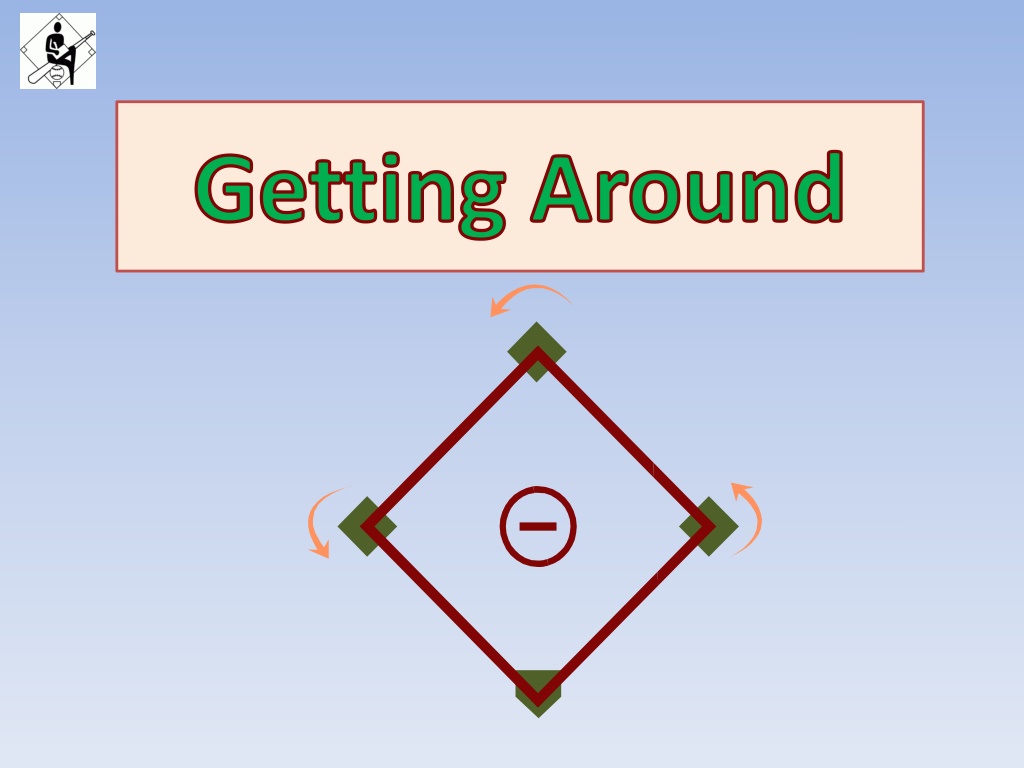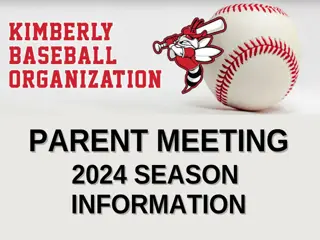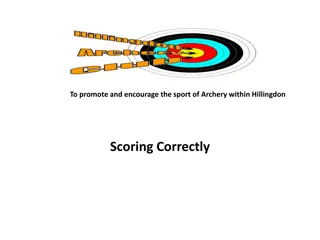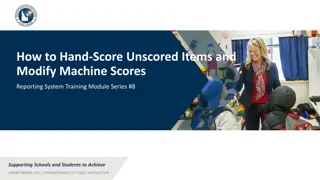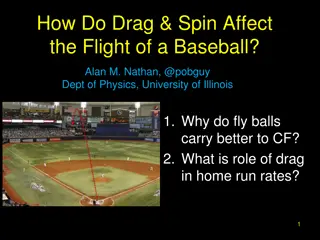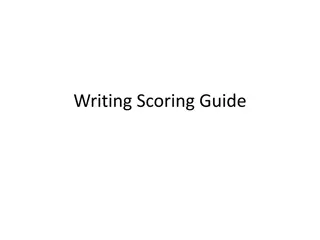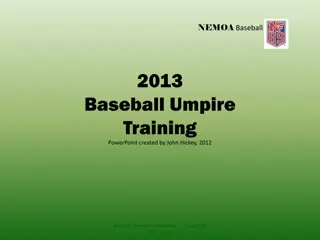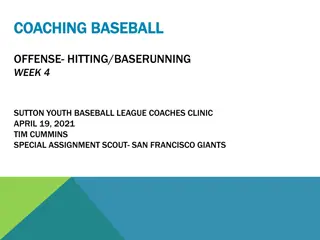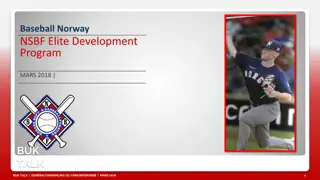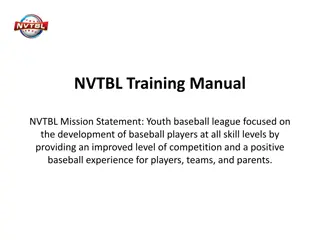Understanding Baserunning and Scoring in Baseball
In baseball scoring, account for every base is crucial for tracking offensive and defensive statistics. Baserunners may advance on various plays involving the battery, batter's actions, fielder's choice, errors, and more. Understanding the rules around wild pitches, balks, stolen bases, and passed balls is essential for accurate scoring. This guide provides insights into the intricate details of baserunning and scoring in baseball, emphasizing the importance of meticulous observation and adherence to official baseball rules.
Download Presentation

Please find below an Image/Link to download the presentation.
The content on the website is provided AS IS for your information and personal use only. It may not be sold, licensed, or shared on other websites without obtaining consent from the author. Download presentation by click this link. If you encounter any issues during the download, it is possible that the publisher has removed the file from their server.
E N D
Presentation Transcript
ACCOUNT FOR EVERY BASE A crucial task for the scorer is to account for every base advanced by the runner. e9 Sb2 - 8 WP3 Why is this crucial? It s all about the STATISTICSfor both OFFENSIVE (runners) and DEFENSIVE (fielders). A T-Ball scorer doesn t need to show HOW a runner made it around from 1st to home, they just need to show it.
Once a runner is on base and a new batter steps up to the plate, the scorer must keep an eye on both the BATTERY (pitcher & catcher) and the BASES. Welcome to the 4-ring circus!
A baserunner may advance on: The BATTERY Stolen Base, Wild Pitch, Passed Ball, Balk The BATTER S ACTION Hits, Outs or Errors The FIELDER S CHOICE a play happening at another base An ERROR an extra base advanced on account of the error Scoring a base advance relies on concentrated observationand scorer s judgment. And remember, ALL of the advances are regulated by the OFFICIAL BASEBALL RULES.
If the pitcher is on the mound pitching or preparing to pitch AND the batter does not hit the ball into play then the baserunning action is considered to be on the BATTERY. BLK # PB # The BATTERY is simply defined as the Pitcher and the Catcher, so any advance on the battery will specifically affect their stats. In the scoring notations, the batting order number of the current batter is used to show when the advance occurred. WP # The scorer shall NOT charge an error when runners advance on a WP, PB or BLK.
WILD PITCH - a pitch that is so high, low, or wide of the plate that it can t be handled by the catcher with ORDINARY EFFORT and allows baserunners to advance. ANY pitch that hits home plate or the ground before reaching the catcher MUST be charged as a wild pitch if a runner advances. BALK - an illegal act by the pitcher with runners on base. The umpire will call time and motion the runners to each advance one base. It is not a pitch on the batter. If the balk pitch is delivered across the plate it will need to be counted in a JUNIOR pitcher s pitch total. Mark with a blue dot. PASSED BALL a pitch that the scorer judges should have been held by the catcher using ORDINARY EFFORT, but it gets away from him and allows baserunners to advance.
A STOLEN BASE is an advance against the battery that is not aided by a hit, out, error, wild pitch, passed ball or fielder s choice (see OBR 9.07). Sb # A SB and CS must both exist as possible outcomes on the one play or else neither is appropriate. In the scoring notations, the batting order number of the current batter is used to show when the advance occurred. DSb # Once a pitch is put into play by the batter a Stolen Base is no longer possible.
Stolen Bases (the nitty-gritty details) The stolen base is perhaps the most misunderstood statistic amongst novice scorers. A stolen base is an advance UNAIDED by a walk or a ball hit into play - or by an error, wild pitch or passed ball. On every STOLEN BASE attempt there must exist an opportunity to throw the runner out CAUGHT STEALING, or else neither is appropriate to score. When more than one baserunner attempts to advance on the battery without the aid of an Error, WP or PB, then ALL THESE BASERUNNERS ARE STEALING. If all advance safely, then ALL are scored as stolen bases, and ALL of them are charged against the catcher in his statistics. Everyone okay with that?
But wait! I hear you say. The catcher can only throw out one runner, so the others must be advancing on his throw and isn t that a Fielder s Choice play?! Well, no. This is one of those situations where you MUST OBEY THE RULES. IF a catcher throws out one runner stealing, then all other stealing runners MUSTbe advanced on a fielder s choice. BUT if all stealing runners advance and none of them are put out caught stealing or would have been except for a decisive error then ALL of them are credited with a stolen base. This is still the case even when the runners don t take off simultaneously, as in a delayed steal. Let s look at a couple of examples
Example 1: Runners on 1st & 3rd base with none out. Batter 9 swings and misses and at the same time the runner from 1st takes off for 2nd. The catcher throws over to the shortstop covering the base, but the runner slides in safely under the tag. On the catcher s throw the runner from 3rd takes off and he also slides in at the plate safely. = 9 DSb 9 8 7 8 E3 DSb 9 Score this as 2 stolen bases (double-steal). The notation for a Double-Steal is DSb # (do not use Sb # with a circle around it)
Example 2: Runners on 1st & 3rd base with none out. Batter 9 swings and misses and at the same time the runner from 1st takes off for 2nd. The catcher throws over to the shortstop who has moved forward of the basepath. On the catcher s throw the runner from 3rd takes off, but the shortstop immediately fires a throw back to the catcher who tags the runner out at the plate. The runner from 1st is safe on 2nd base. FC 2 = 9 WP 8 1 7 8 CS 2-6-2 BB Score this as a Caught Stealing and a Fielder s Choice.
Once the batter hits a pitch into play there is NO further possibility of advancing on the battery. The advancement will then be judged as on the batter s action, on a fielder s choice, or on an error.
Advancing on the Batter 5 In most cases when a base runner advances after the batter has put a ball in play the advance will be credited to the batter. 3-2-5 4 9 7 3 -9 7 HPB 6 Sometimes it s due to a force, and sometimes it is due to a well-hit ball, which can account for more than 1 base if the hit is very good. 7 5 S 8 1 -8 8 F9 If a runner advances home due to the batter putting the ball in play, this may be a Run Batted In (RBI) for the batter. Take care - an RBI must conform to the rules regarding when it can be credited (OBR 9.04). 7 8 6 2 BB 9 9 UA3
Runs Batted In A Run Batted In ( Ribby )is a statistic credited to a batter whose action at bat causes one or more runs to score: Rule 9.04 Credit an RBI to the batter for each run his action has scored, which is unaided by an error and as part of a play begun: oby the batter s Safe hit (including his own home run!) oby the batter s Sacrifice fly or Sacrifice bunt oby the batter s infield out or fielder s choice, UNLESS (this is very important) the batter grounds into a force or reverse force double play (GDP) or a fielder muffs (drops) a throw at first base that would have completed a force double play oby the batter s award of first base with bases loaded (BB, HPB, INT2, OBS). o when, before there are 2 outs, an error is made on a play in which a runner from third base ordinarily would score.
Example: None out, runner on 3rd, routine fly ball to right field which the runner will tag up and score on (Sacrifice Fly) - but the catch is dropped. The runner takes off after the drop and scores. Credit the Sac Fly + RBI (no AB) and charge an Error on the right fielder. Example: Two outs, bases loaded, batter hits a routine grounder to shortstop who throws the ball to the first base fielder in time for the out but the throw is wide and all runners advance a base. Charge an Error (decisive) on the shortstop and score ALL bases advanced on the error (E6 & e6). And remember, if there are already 2 outs (NOT 1 out + 1 error) and then a decisive error is made, an RBI can NOT be credited.
Advancing on Fielders Choice 8-5 5 The notation FC is used to score a batter s arrival on 1st when a fielder handles a ground ball and makes a play at another base. (See Rule 2 definition of Fielders Choice.) 1 8 4 FC 9 - 6 7 9 CS 2-5 - 9 FC 9 3 But it is also used to describe the advance of runners for the following reasons: FC 8 2 7-2-5- 4-6 5 When the batter-runner makes a safe hit and takes an extra base due to the play on another base runner - 8 8 - 9 When a runner advances (other than by SB or E) while a fielder attempts to put out another runner FC 2 7 FC 7 6 When a runner advances due to defensive indifference Eg: an undefended steal (Refer 9.07g) 8 BB 9 - 7
Advancing on Fielders Choice 8-5 5 NOTE! 1 8 4 FC 9 - 6 7 FC must be used to score the run on a GDP play. 9 CS 2-5 - 9 FC 9 3 FC 8 2 FC must be scored when a double-steal is attempted and one runner is put out CS (or is safe on an errored CS). 7-2-5- 4-6 5 - 8 8 FC is scored if two runners try to advance on WP/PB and one is thrown out. - 9 FC 2 7 FC 7 6 FC is NOT USED if two runners advance on a steal attempt and both are safe, even if one has waited for the throw before advancing. 8 BB 9 - 7
Advancing on an Error MF9 8 S 1-5 5 e4 Runners can advance a base on an error made by the fielders trying to make an out on the batter or a runner (Decisive Error). If more than one runner advances on the same error, the error is circled to show that it has already been counted in the fielding stats. 4 2 DSb6 - 9 7 PO wt2 DSb6 5 6 1 E4 8 The fielders may make an error just trying to field or throw the ball and the judgment is that no out was missed, but the runners advanced on the error (Extra Base Error). 4-3 CS 2-E6 e7 = 7 wt1 6 3 7 9 Remember: Decisive errors (missed outs) are in UPPER case and Extra base errors are in Lower case, and all are in RED. 8-6-2 BB
Getting Around Quick Quiz With bases loaded the batter hits a home run. How many RBI s are credited to him? 4 RBI s (3 baserunners, plus himself) Can an RBI be scored if the batter grounds into a double play and a runner from 3rd comes home? No, score as a Fielders Choice (by rule, an RBI is not allowed on a GDP) When a batter makes a safe hit and takes second base while the fielder tries to throw out another runner, is this scored as a single or a double? Score a Single + Fielders Choice (advanced on the throw) Define the Battery: The Pitcher and the Catcher (not when pitch is hit into play) Name the advances made on the Battery: Wild Pitch (WP), Passed Ball (PB), Stolen Base (SB), Balk (BK) Explain the difference between a decisive error and an extra base error: Decisive = an out was missed. Extra Base = a base was gained due to the error, but no out missed How do you show that 2 runners advanced on one error? Circle one of the errors, and use lower case letters for the circled error. If a runner from 3rd scores when the batter reaches 1st on an error, explain when an RBI can be scored: If there were less than 2 outs and the runner would ordinarily score. If the batter makes a single base hit, but takes 2nd after the fielder throws the ball into the stands, how is this scored? Score as a single plus an extra base error and link the two: -7 + wt7
